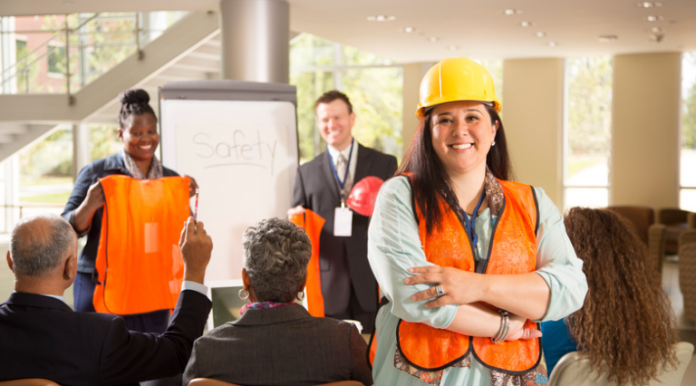Table of Contents
The primary responsibility of safety in the workplace falls on the employer, but employees, too, must contribute to a safer working environment. In other words, safety is a team effort. All people within the organisation must support safety, so don’t adopt an “it’s not my job” attitude. A safe workplace is a happy workplace. Become invested in shared responsibility and contribute to the overall safety of your co-workers. How? Keep on reading to find out.
Report Unsafe Conditions

If you have reason to believe that working cultures are unsafe, bring it to your employer’s attention without delay to prevent a disaster. Maybe you’re scared to talk about unsafe conditions and hazards with your superiors, thinking it might get you (or someone else) in trouble. You must understand that it can increase the chances of an accident or injury, so file a complaint.
Corporations have a formal complaint procedure in place, so you can voice your concerns; you have the option to make your report anonymously. If you don’t want to raise the matter with your employer as a grievance, talk to them informally. You might find it helpful to suggest what they could do to solve the issue.
Unsafe conditions can lead to injury, illness, and even death, creating an atmosphere that impacts productivity. Accidents can happen. If the employer had knowledge about the unsafe work conditions and the risk of harm, the victim could bring a lawsuit against them to ensure they’re fairly compensated. It’s the last resort, of course, but at times, it’s the only way to stand up to injustice. Workplace accidents, and other types of incidents, occur mostly because of the hazards present in the surroundings, of which mention can be made of:
- Poor lighting conditions
- Spills
- Frayed wires, missing ground pins
- Poorly maintained equipment
- Lack of cleaning & poor housekeeping
Unsafe work conditions (or workplace hazards) should be addressed as soon as possible.
Use Tools, Equipment, And Machinery Adequately


Any person, no matter how skilled or trained, can commit an error, meaning that the human factor can be a contributor to accidents. Practicing the proper use of tools, equipment, and machinery is recommended to prevent injuries. Most importantly, encourage others to ask questions if they need help.
As you might already know, there’s a clear distinction between a human error and a violation. You make a mistake when you do something unintentionally, but when you knowingly break the rules or disregard practices, you commit a violation. Breaching workplace safety standards, regulations, policies, or rules could earn you a fine. Equally, your employer might take corrective action.
Take Frequent Breaks
Fatigue is to blame for many accidents in the workplace, contributing to human error. A chronic or acute state of exhaustion can lead to slow reaction time, memory issues, reduced eye movement, blurred vision, reduced coordination and motor skills, and increased risk-taking.
If you’re tired, you’re a liability on the job, so take regular breaks. It will allow your body to relax and recharge; when you get back to work, you’ll be more focused and have a higher concentration level. Schedule the most difficult tasks when you’re fresh, preferably upon morning arrival.
Spot fatigue in your co-workers. Obvious indicators that someone is tired and needs to recover before they make costly errors or accidents happen are:
- Incessant yawning
- Eyelids that seem to be closing
- Difficulty concentrating
- Reduced reflexes & responses
- Irritability
- Muscle weakness
Working overnight shifts will no doubt lead to fatigue, so talk to your employer about rotating shifts. It’s best not to deprive the same people of sleep (or the ability to have personal time).
Never Take Shortcuts
Policies and procedures won’t do any good if people don’t follow them. Skipping a step or not wearing personal protective equipment might save time, but it’s not worth the risk. Even if you’re in a rush to finalise a task, taking shortcuts must be avoided at all costs. Regarding safety, there’s no room for shortcuts – you are putting yourself at risk, and others. Therefore, follow the rules and avoid getting into trouble. The rules exist to make workplaces as safe as they can be, so the best option is to follow them.
Safety is of the essence, and shortcuts shouldn’t be tolerated. If you don’t skip steps and wear PPE, co-workers will be inclined to do the same, so encourage positive behaviour. Raise the bar by demonstrating how to address challenges while maintaining the right attitude; making mistakes can open the door to teaching opportunities.
Perhaps you feel pressure to get work done on time. Pause for a second and see if this pressure is external. Chances are that you’re challenging yourself to complete a task quicker just to make a good first impression. Success or failure feels like a reflection of your worth.
Offer Guidance to Others


Finally, yet importantly, you must guide new employees who’re eager to learn. Educate them on the organization’s safety culture, let them know what standards it upholds, and ensure they’re fully invested in the value the safety brings. Together, you can create a safer workplace.
Indeed, it’s the responsibility of the company to make the staff aware of safety procedures, but you can lend a helping hand. You have the best understanding of how work gets done and, most importantly, where the dangers might be hiding. Provide advice around the clock and let others refresh their memory when necessary.
The Takeaway
Safety in the workplace is everyone’s responsibility, meaning it’s a duty that all workers share. You and the people with whom you work are the first lines of defence against accidents, so make sure to use safe practices every day. Take training seriously, be patient with your job, speak up about unsafe conditions, and learn from near misses and injuries. Incidents happen when the entire team doesn’t collaborate to maintain strict practices. Thus, each person at the company is accountable.






































